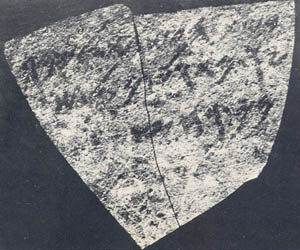Image Details

Courtesy of The Israel Department of Antiquities and Museums
The Samaria ostraca, potsherds bearing inscriptions in ink, were either invoices or labels for wine and oil shipments. This example from the eighth-century B.C. hoard of 102 ostraca, found in the storerooms of the Israelite kings’ palace in Samaria, exhibits a skilled hand that may indicate the work of a professional scribe. The text says: “In the tenth year. (Belonging) to Shamar/iau of Ttl. A nbl of / fine oil.” A nbl was a type of vessel that held a standard quantity.
Ostraca were used as scratch pads, a handy material on which to record ephemeral information. No known ostracon appears to have been intended for a library or archive. Ironically, the unimportant ostraca survived, whereas the more important documents, such as legal deeds and government records written on highly perishable papyrus, decayed in Canaan’s damp climate. At least 17 sites, including Samaria and Jerusalem, many of them small settlements in Judah and the Negev, have yielded ostraca. This suggests that writing may have been relatively common, because it is hard to believe that scribes would have been so widely available, even in villages, or would have been employed for such minor tasks.
